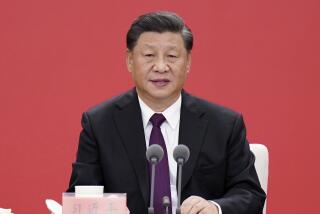NEWS ANALYSIS : Some Officials Doubt U.S. Has Game Plan for Japan : Trade: Others say strategy is secret to keep Tokyo off balance. Effect on other Asian issues is a concern.
WASHINGTON — Despite President Clinton’s tough talk about Japan’s trade policy, the Administration appears to lack both a grand strategy and a day-by-day game plan for prying open Japan’s markets, according to government sources and trade experts.
In the aftermath of the unsuccessful talks Feb. 11 between Clinton and Japanese Prime Minister Morihiro Hosokawa, a senior U.S. official admitted privately a week later, “We’ve been trying to figure out what to do next.”
There is agreement within the Administration on the need to confront Japan but uncertainty over how to do it and whether the get-tough approach will have the desired effect, senior Administration trade and economic officials say.
“Believe it or not,” a senior U.S. official said, “we didn’t think through in advance what we would do” if the summit meeting failed to find common ground.
Complicating matters are concerns within the Administration that any display of disunity will send misleading signals to Asia, where the United States is engaged on such sensitive military and political issues as opposition to the development of nuclear weapons in North Korea and insistence on respect for human rights in China.
Other Administration officials insist that they do indeed have a carefully mapped strategy but are keeping it secret to put the Japanese off balance. They promise to begin unveiling a series of steps soon--possibly as early as this week--in their effort to keep the pressure on Japan to reduce its $60-billion-a-year trade surplus with the United States.
“The goals are clear, the strategy is clear and the tactics have been consistent,” U.S. Trade Representative Mickey Kantor said in an interview. “I don’t think there is any doubt about what the Administration wants to accomplish.
“For three weeks we have had a menu of options. They have been thoroughly reviewed and precisely calculated as to what they might mean to our economy and to the Japanese economy. And when we make our decisions, they’ll be done on a rational, calculated basis.”
Another senior official deeply involved in the on-again, off-again negotiations in Washington and Tokyo said: “Is there a strategy? Of course there is. What you cannot quantify is how long it will take. We are doing everything we can to make sure things don’t happen by accident. We have a deliberate strategy. It’s really delicate stuff.”
Administration officials and others familiar with these plans say they include:
* Renewing a provision in U.S. trade regulations to allow the government to cite the Japanese for following unfair trade practices, a step that could lead to U.S. retaliation.
* Slowing auto imports with extensive dockside safety inspections, a harassment tool devised by Japan.
* Scaling back tax benefits given to Japanese auto manufacturers in the United States.
* Stepping up the use of U.S. laws prohibiting the “dumping” on U.S. markets of goods sold at less than the price in the home market.
It is an approach that is intended “to show we are serious rather than to achieve an immediate resolution of the dispute,” said one economist who advises Clinton privately. “Certainly the President’s and Mickey Kantor’s views are pretty clear. They are very clear that they want to make Japan a more open economy. How to do that--there’s not an exact game plan.”
And one former government trade expert who has advised Administration trade officials complained, “This is guerrilla warfare, but what you need is all-out conventional war.”
“They are looking at a slow escalation of issues,” said a source close to the Democratic congressional leadership who is generally sympathetic to the Administration’s trade policies. “But they don’t have a step-by-step plan. At some point they have to have an integrated strategy that takes account of day-to-day moves.”
The complicated trade game, he said, is the equivalent of a three-dimensional chess game. So, he was asked, how many moves ahead has the Administration thought?
“I don’t think many,” said the congressional aide, who, like others who support the Administration’s trade campaign and in many cases have helped prepare it, spoke on the condition of anonymity.
Critics say the Administration’s uncertainty illustrates the same sort of failure of strategic planning that has plagued the Administration’s diplomatic policy generally.
“They thought the Japanese always cave in at the eleventh hour, and they had no strategy,” said Carla Hills, Kantor’s predecessor as U.S. trade representative in the George Bush Administration. “They’re hung up on numbers, and it’s a dead end.”
Columbia University economist Jagdish Bhagwati, a former adviser to the General Agreement on Tariffs and Trade, blames the Administration for failing to recognize the scope of the political upheaval taking place in Japan. He also faults its refusal “to think through their position and come out with policies that make sense.”
“The new Japan is trying to be like the old United States, and the new United States is trying to be like the old Japan,” Bhagwati said.
As evidence, he pointed to Japan’s move toward political openness and away from managed trade. Meanwhile, he said, the United States is insisting on arriving at “objective” benchmarks to measure its access to the Japanese market.
Within the Administration and among trade experts, said Paula Stern, a former member of the International Trade Commission, a debate is continuing over the best course to follow: trying to open the Japanese market industry by industry, as in the past, or sending an unambiguous message that the Japanese economy must be thoroughly deregulated and restructured.
The Administration has largely chosen elements from both paths. It has called for major changes in Japan’s way of doing business, echoing Hosokawa’s political mandate when he led the rebellion against four decades of political rule by the Liberal Democratic Party. At the same time, it has concentrated its firepower on four sectors--telecommunications, medical equipment, insurance, and automobiles and auto parts--as the initial targets for foreign penetration.
“It’s important in this transitional period that the Clinton Administration give a clear-cut signal we won’t be satisfied with a bloodletting in one industry,” Stern said.
At the same time, others have said, there is some debate--denied by a senior Treasury official--that sensitive currency manipulation is required. In such a course, the value of the dollar would be weakened against the yen to make U.S. exports cheaper and Japanese imports more expensive.
Missing, too, they complain, has been a direct linking of economic and security issues.
“I do think you have to see it in a more integrated way, but that hasn’t come about because it’s been a disparate process,” said one Clinton adviser, pointing out that the State Department and Pentagon are reluctant to jeopardize the security relationship.
But among the Administration’s most consistent trade allies in Congress, such as Rep. Robert T. Matsui (D-Sacramento), there is little worry.
“My guess is it will work itself out,” said the chairman of the Ways and Means subcommittee on trade. “The Japanese (will) understand when we say something we mean it, and we will treat the Japanese as equal trading partners. They have their own point of view and will be respected.”
Times staff writer Jim Mann contributed to this report.
More to Read
Sign up for Essential California
The most important California stories and recommendations in your inbox every morning.
You may occasionally receive promotional content from the Los Angeles Times.










